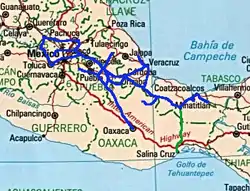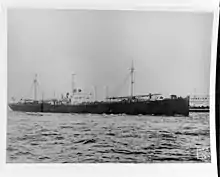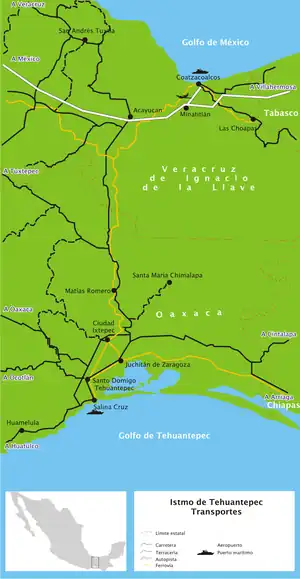Ferrocarril Transístmico
The Ferrocarril del Istmo de Tehuantepec (Ferrocarril del Istmo de Tehuantepec, S.A. de C.V.), also known as Ferrocarril Transístmico (Spanish: Trans-Isthmic Railroad) or simply Ferroistmo,[1] is part of the Interoceanic Corridor of the Isthmus of Tehuantepec, owned by the Mexican government, that crosses the Isthmus of Tehuantepec between Puerto Mexico, Veracruz, and Salina Cruz, Oaxaca. It is leased to Ferrocarril del Sureste FERROSUR.
 Map of Ferroistmo line (in green) from Salina Cruz to junction with Ferrosur lines (in blue) to Veracruz and Coatzacoalcos | |
| Overview | |
|---|---|
| Locale | Isthmus of Tehuantepec |
| Predecessor | FCCM |
| Technical | |
| Track gauge | 1,435 mm (4 ft 8+1⁄2 in) standard gauge |
| Other | |
| Website | www |
It was formerly leased to Ferrocarriles Chiapas-Mayab until Genesee & Wyoming gave up its concession in 2007.[2] Originally it was known as the Tehuantepec Railway.
History of the Tehuantepec Railway
The potential of the route from the Atlantic to the Pacific across the Isthmus of Tehuantepec has long been appreciated. As early as 1814 the Spanish government authorized a canal across the Isthmus. Soon after Mexico became independent in 1821, surveys were carried out which recommended constructing a plank trail for wagons through the Chivela Pass, with the northernmost part of the route using the Coatzacoalcos River which flows northward to the Gulf of Mexico on the Atlantic side of the isthmus. The river would be dredged to allow navigation. Nothing came of either of these plans.[3][4][5]

More serious planning began in the early 1840s, when José de Garay, the First Officer of the Ministry of War obtained a concession on the route and carried out a more thorough survey.[3] After many failed attempts to obtain funding, the concession was taken over by a New Orleans company, The Tehuantepec Railroad Company of New Orleans (TRCNO). Despite diplomatic problems over the status of the concession, a further survey of the route was carried out by Major John G. Barnard. This was published in 1852.[6]
The years between 1852 and 1861 were turbulent both diplomatically and financially. The opening of the Panama Railroad in 1854 provided competition for the Tehuantepec route, but also gave warning that the TRNCO's cost estimates were wildly optimistic. The Panic of 1857 made raising capital for transportation projects more difficult. There were disputes over the concession with the Mexican Government.[7] In spite of this, the company managed to construct a wagon trail (not a railroad) along the route, and offer a service for passengers and mail from New Orleans to San Francisco, starting in 1858. It was too little too late, however, and the company became insolvent in 1860. The outbreak of the American Civil War and the French intervention in Mexico the following year ended any immediate hope of reviving the project.[5]
After the Civil War ended, there was once again interest in trans-isthmus routes, in particular for a canal. A commission was appointed by the US Government in 1872. A new survey of the Tehuantepec route had been carried out by Admiral R. W. Shufeldt in 1870, but in spite of his positive report[8] the commission recommended a route through Nicaragua in 1876.[9] No government action resulted, however, and actual canal construction was started in Panama in 1881 by a French company headed by Ferdinand de Lesseps.
A radically different solution was proposed by James B. Eads - a ship-railway. Rather than a canal, he proposed a 6-track railway across the isthmus, with ships of up to 6,000 tons carried in a specially designed cradle.[10] Eads' ideas received considerable support in the USA, but he died in 1887, and this was effectively the end of the proposal.[9]

Railroad construction actually continued during this period, and the line was completed in 1894. However it had many problems, including inadequate port facilities at each end, and varying standards of construction along the route. It soon became clear that a complete overhaul was necessary, and Weetman D. Pearson was contracted by the Mexican Government to undertake the work. The line was stabilized, and where necessary structures were rebuilt. Port facilities were established at Coatzacoalcos and Salina Cruz. The newly refurbished line opened in 1907.[11][12][9] The locomotives on the line were oil-burning steam locomotives. The Tehuantepec Railroad was one of the first to use this source of power.[13]

The American-Hawaiian Steamship Company, which had been operating from San Francisco and Hawaii to New York through the Straits of Magellan contracted to provide connecting steamship lines to both ends of the railroad, allowing a 25 day service between San Francisco and New York.[15] Sugar became a major part of the freight, amounting to 250,000 tons annually,[16] and most of the sugar from Hawaii to Philadelphia and New York was carried on this route.[17]
The railroad prospered for seven years, until the Panama Canal opened in 1914. Despite optimistic forecasts that there was plenty of business for both the railroad and the canal,[4] business declined drastically after 1914, not helped by the Mexican Revolution and the onset of the First World War. The railroad continued to handle substantial passenger traffic well into the fifties, but ceased to be a significant carrier of freight.[12][9]
Redevelopment
.jpg.webp) Railway bridge in Jesús Carranza. | ||||||||||||||||||||||||||||||||||||||||||||||||||||||||||||||||||||||||||||||||||||||||||||||||||||||||||
| Overview | ||||||||||||||||||||||||||||||||||||||||||||||||||||||||||||||||||||||||||||||||||||||||||||||||||||||||||
|---|---|---|---|---|---|---|---|---|---|---|---|---|---|---|---|---|---|---|---|---|---|---|---|---|---|---|---|---|---|---|---|---|---|---|---|---|---|---|---|---|---|---|---|---|---|---|---|---|---|---|---|---|---|---|---|---|---|---|---|---|---|---|---|---|---|---|---|---|---|---|---|---|---|---|---|---|---|---|---|---|---|---|---|---|---|---|---|---|---|---|---|---|---|---|---|---|---|---|---|---|---|---|---|---|---|---|
| Service type | Regional rail, freight rail | |||||||||||||||||||||||||||||||||||||||||||||||||||||||||||||||||||||||||||||||||||||||||||||||||||||||||
| Status | Under construction | |||||||||||||||||||||||||||||||||||||||||||||||||||||||||||||||||||||||||||||||||||||||||||||||||||||||||
| Locale | locale | |||||||||||||||||||||||||||||||||||||||||||||||||||||||||||||||||||||||||||||||||||||||||||||||||||||||||
| First service | September 2023 (freight)[18] December 22, 2023 (passenger, planned)[19] | |||||||||||||||||||||||||||||||||||||||||||||||||||||||||||||||||||||||||||||||||||||||||||||||||||||||||
| Current operator(s) | Ferrocarril del Istmo de Tehuantepec | |||||||||||||||||||||||||||||||||||||||||||||||||||||||||||||||||||||||||||||||||||||||||||||||||||||||||
| Route | ||||||||||||||||||||||||||||||||||||||||||||||||||||||||||||||||||||||||||||||||||||||||||||||||||||||||||
| Termini | Coatzacoalcos Salina Cruz | |||||||||||||||||||||||||||||||||||||||||||||||||||||||||||||||||||||||||||||||||||||||||||||||||||||||||
| Stops | 10 | |||||||||||||||||||||||||||||||||||||||||||||||||||||||||||||||||||||||||||||||||||||||||||||||||||||||||
| Distance travelled | 214 kilometres (133 mi) | |||||||||||||||||||||||||||||||||||||||||||||||||||||||||||||||||||||||||||||||||||||||||||||||||||||||||
| Technical | ||||||||||||||||||||||||||||||||||||||||||||||||||||||||||||||||||||||||||||||||||||||||||||||||||||||||||
| Rolling stock | See rolling stock | |||||||||||||||||||||||||||||||||||||||||||||||||||||||||||||||||||||||||||||||||||||||||||||||||||||||||
| Track gauge | 4 ft 8+1⁄2 in (1,435 mm) standard gauge | |||||||||||||||||||||||||||||||||||||||||||||||||||||||||||||||||||||||||||||||||||||||||||||||||||||||||
| ||||||||||||||||||||||||||||||||||||||||||||||||||||||||||||||||||||||||||||||||||||||||||||||||||||||||||
On 7 June 2020, President of Mexico Andrés Manuel López Obrador announced the beginning of the rehabilitation of the line. It will cost 3 billion pesos to begin the project, but in total, the project will cost 20 billion pesos.[20]
The project for the rehabilitation of the line will result in the speed of freight trains increasing from 20 kilometres per hour (12 mph) to 70 kilometres per hour (43 mph), more than three times the current speed. Furthermore, this project will also lead to the introduction of a passenger train, which will be able to reach speeds of up to 100 kilometres per hour (62 mph).[20]
It will also enable links to existing freight lines, including the Palenque-Coatzacoalcos and Chiapas-Veracruz lines, as well as another railway line that extends from the Interoceanic Corridor of the Isthmus of Tehuantepec (CIIT, by its initials in Spanish) to the city of Tapachula, in Chiapas.
The work includes the application of aluminum-thermal welding on rails, application of paint on bridges and structures, dismantling, weeding, and cleaning of ditches. This will be done through the work of crews of personnel for the railroad, and through the hiring of private companies.[21]
The Medias Aguas-Salina Cruz section of the passenger railway performed its first tests in September 2023, including an official trip by the President and his staff, and the director of the CIIT, viceadmiral Raymundo Morales Ángeles, stated that it will begin passenger operation in December, though cargo operations did officially begin in September.[22] This opening includes 227 kilometers of roads, 82 bridges and 290 drainage works. The modernization of this section, known as Line Z (Spanish: Línea Z), includes complementary works such as nine passenger stations, seven slopes, two supply stations, seven workshops, four yards, a single control and dispatch center, and two depots.[23]
Rolling stock
In August 2023, the website Railtech.com reported a number of InterCity 125 high-speed train sets, originally built for British Rail, had been seen at the Port of Great Yarmouth being loaded on to a ship bound for Mexico. Unconfirmed reports suggested this second-hand rolling stock was bound for the Ferrocarril del Istmo de Tehuantepec.[24]
On September 4, 2023, the news website Diario del Istmo posted a story containing a powerpoint slide from the Sistema Portuario Nacional, confirming that a group of 3 Class 43 locomotives and 11 Mark 3 coaches had been exported to Mexico for use on Ferrocarril del Istmo de Tehuantepec.[25]
In addition to these InterCity 125 trainsets, several other types of rolling stock will be used. The Ferrocarril Transístmico purchased two EMD SD70M locomotives from the Union Pacific Railroad.[26][27] and 12 passenger cars (including 3 Amfleet cars and the Stampede Pass, a dome car built by the Budd Company in 1954) from the Railway Excursion Management Company (Railexco).[28] The first of the SD70Ms were presented on August 13, 2023.[26][27]
In addition to these, on August 26, 2023, the two Stadler Citylink sets from the former Puebla-Cholula Tourist Train were brought to Coatzacoalcos railway station for use on the Ferrocarril Transístmico.[29][30]
Transport Routes in the Isthmus of Tehuantepec
Map from Wikicommons

See also
- Coatzacoalcos–Palenque Line, another line to be operated by Ferrocarril Transístmico
- Ixtepec–Ciudad Hidalgo Line, another project by Ferrocarril Transístmico, to be opened in July 2024[31]
- American-Hawaiian Steamship Company
- Ferrocarril de Veracruz al Istmo
- List of Mexican railroads
References
- McManus, Lowell G. "The Mexican Railways". Retrieved 2011-01-31.
- Central America going nowhere. Railway Gazette International August 2007.
- de Garay, Jose (1844). Survey of the Isthmus of Tehuantepec, Executed in the Years 1842 and 1843. London: Ackerman and Co.
- Corthell, E.L. (1904). "The Tehuantepec Route". The Railroad Gazette. 34 (5): 154–157.
- Gordon, Nicolas Edward (2013). From the Crescent City to Jaguar Hill: New Orleans business interest in the Tehuantepec National Railroad of Mexico (MA). University of Oklahoma.
- Williams, John Jay (1852). The isthmus of Tehuantepec : being the results of a survey for a railroad to connect the Atlantic and Pacific oceans, made by the scientific commission under the direction of Major J.G. Barnard, U.S. engineers. New York: D. Appleton & Company.
- Rippy, J. Fred (1920). "Diplomacy of the United States and Mexico Regarding the Isthmus of Tehuantepec, 1848-1860". The Mississippi Valley Historical Review. 6 (1): 503–531. doi:10.2307/1886471. JSTOR 1886471.
- Stevens, Simon; Barnard, J.G.; Williams, J.J.; Adams, Julius W. (1872). "The New Route of Commerce by the Isthmus of Tehuantepec". Journal of the American Geographical Society of New York. 3: 300–342. doi:10.2307/196423. JSTOR 196423.
- Winberry, John J. (1987). "The Mexican Landbridge Project: The Isthmus of Tehuantepec and Inter-Oceanic Transit". Yearbook.Conference of Latin Americanist Geographers. 13: 12–18. JSTOR 25765675.
- Corthell, Elmer Lawrence (1886). The Atlantic & Pacific ship-railway across the Isthmus of Tehuantepec.
- Hovey, Edmund Otis (1907). "The Isthmus of Tehuantepec and the Tehuantepec National Railway". Bulletin of the American Geographical Society. 39 (2): 78–91. doi:10.2307/198380. JSTOR 198380.
- Glick, Edward B. (1953). "The Tehuantepec Railroad: Mexico's White Elephant". Pacific Historical Review. 22 (4): 373–382. doi:10.2307/4492098. JSTOR 4492098.
- Aston, R. Godfrey (1911). "Oil-Burning Locomotives on the Tehuantepec National Railroad, Mexico". Proceedings of the Institution of Mechanical Engineers. 81 (1): 1023–1047. doi:10.1243/PIME_PROC_1911_081_021_02.
- "Traffic News". Railway Age Gazette. 48 (11): 744. 1910.
- "A new trans-continental competitor". The Railroad Gazette. 39 (4): 74–75. 1905.
- "Hearing regarding Pacific Coast rate cases". Railway Age Gazette. 50 (14): 872–873. 1911.
- "Transcontinental traffic via Tehuantepec". The Railroad Gazette. 44 (12): 423. 1908.
- Villa Román, Elisa. "Tren Interoceánico del Istmo de Tehuantepec: ruta completa, estaciones y fechas de inauguración". El País. Retrieved 4 October 2023.
- ""El 22 de diciembre se inaugura el Tren del Istmo": AMLO". www.proceso.com.mx (in Spanish). Retrieved 15 October 2023.
- Pérez, Maritza. "Inician obras de rehabilitación del Ferrocarril del Istmo de Tehuantepec". El Economista. Retrieved 2022-04-25.
- "Ferrocarril del Istmo de Tehuantepec. S.A. de C.V. » Rehabilitación, Conservación y Mantenimiento de Vías, Puentes y Estructuras del Ferrocarril del Istmo de Tehuantepec, S.A. de C.V." (in Spanish). Archived from the original on 27 May 2022. Retrieved 2022-05-21.
- Villa Román, Elisa. "Tren Interoceánico del Istmo de Tehuantepec: ruta completa, estaciones y fechas de inauguración". El País. Retrieved 4 October 2023.
- "Primera fase del Tren del Istmo se inaugurará en agosto; tiene avance del 80 %". Imagen del Golfo (in Mexican Spanish). Retrieved 2023-06-15.
- "British High Speed Trains set for Mexico". August 29, 2023.
- "Llegaron más locomotoras para el Tren Interoceánico en Coatzacoalcos". September 4, 2023.
- "Presentan primera locomotora del Tren Interoceánico del Istmo de Tehuantepec - Centro Urbano" (in Spanish). Retrieved 4 October 2023.
- "Llegó la locomotora del mega proyecto del Tren Interoceánico del Istmo de Tehuantepec". MXCity (in Spanish). Retrieved 4 October 2023.
- WordPress.com. (2023-08-29). "Vienen vagones antiguos y de súper lujo para el Ferrocarril del Istmo; cubrirán ruta Coatzacoalcos-Salina Cruz". Costa Veracruz (in Spanish). Retrieved 2023-09-08.
- "Llegan a Coatzacoalcos, Veracruz, dos locomotoras del Tren Interoceánico del Corredor Transístmico". La Silla Rota (in Spanish). August 26, 2023. Retrieved October 4, 2023.
- "Arriba tren que se usará en proyecto del Ferrocarril del Istmo de Tehuantepec". Al Calor Politico (in Spanish). Retrieved October 4, 2023.
- Villa Román, Elisa. "Tren Interoceánico del Istmo de Tehuantepec: ruta completa, estaciones y fechas de inauguración". El País. Retrieved 5 October 2023.
Further reading
- Dunn, Archibald Joseph (1896). The Tehuantepec Railway, A New Through Route to the East.